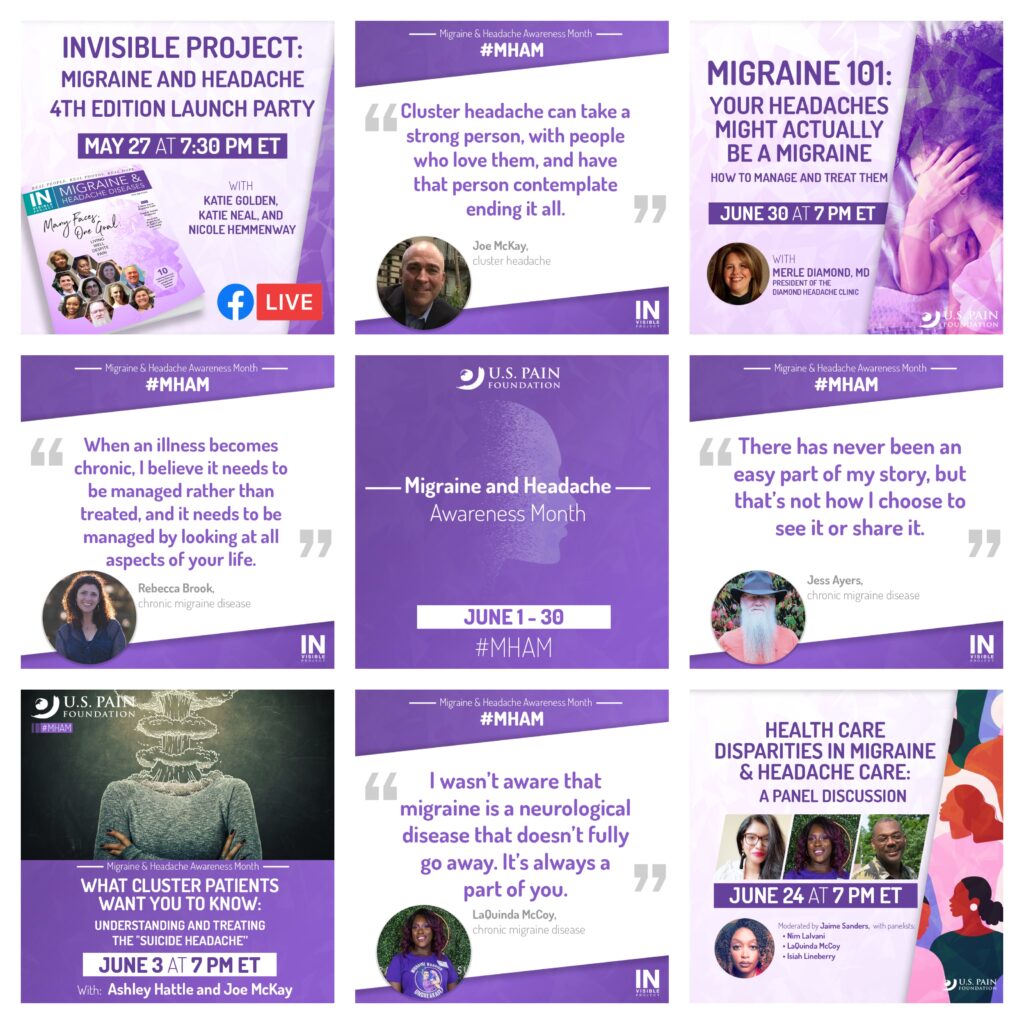 Throughout June as National Headache and Migraine Awareness Month (MHAM), the U.S. Pain Foundation and fellow patient organizations focused their efforts on educating patients and the public about the realities of life with headache diseases. (And even though it’s July, there are still a few opportunities to learn and take action!)
Throughout June as National Headache and Migraine Awareness Month (MHAM), the U.S. Pain Foundation and fellow patient organizations focused their efforts on educating patients and the public about the realities of life with headache diseases. (And even though it’s July, there are still a few opportunities to learn and take action!)
Launch of the INvisible Project: Migraine & Headache 4th Edition
The month kicked off with multiple launch parties for the newest edition of the INvisible Project, which highlights 10 patients and families coping with varying types of headache diseases ranging from cluster headache to new daily persistent headache. You can download the full PDF of the magazine or order print copies, free of charge, by visiting the INvisible Project website.
State advocacy campaign
Last year, U.S. Pain brought its INvisible Project traveling displays to two state houses. Because of COVID-19, this year, the initiative went virtual as an online action campaign. The campaign allows participants to send emails to their state legislators with a video of INvisible Project participants discussing three policy asks: 1) improved access to innovative treatments, 2) more telehealth options, and 3) including mental health care as part of a comprehensive treatment plan.
[su_youtube url=”https://www.youtube.com/watch?v=EFpk3j1LwNw&t” width=”720″ height=”380″]
Thus far, advocates from 42 states have sent 612 emails to 360 policymakers. Help us reach all 50 states by taking part now!
Educational webinars
U.S. Pain also held three educational webinars, each exploring migraine and headache disease from a unique angle. All events were recorded and can be watched through the links below.
- “What cluster patients want you to know.” Ashley Hattle, a leading patient advocate, and Joe McKay, a 9/11 responder (McKay) joined an intimate conversation led by Katie Golden, U.S. Pain’s Migraine Advocacy Liasion, about what’s known as the “suicide headache.”
- “Addressing health care disparities in migraine and headache care.” This discussion, led by Jaime Sanders, featured panelists Nim Lalvani, Isiah and Shelia Lineberry, and LaQuinda McCoy discussing a number of issues related to health care disparities, indulging how to advocate for yourself in the medical system as a Black, Indigenous, or Person of Color and ways patient organizations can better serve diverse communities.
- “Migraine 101: Your headaches might actually be migraine and how to manage and treat them.” This presentation by Merle Diamond, MD, provided a back-to-basics lesson for individuals who might not ralize their head pain is actually a migraine attack–and could be effectively treated by a number of disease-specific treatment options.
Blog highlights
Lastly, thanks to pain warrior writers, U.S. Pain was proud to share several blogs related to migraine and headache diseases during the month, including:
- “The importance of role models,” by Heidi Brehm
- “Mind you,” by Mia Maysack
- “Perseverance over pain: How a clinical trial changed one patient’s life,” a Q&A with Jennie Latson
A joint effort
U.S. Pain was only one of numerous organizations in the headache community that partnered together to coordinate efforts for MHAM.
“U.S. Pain’s efforts were just one part of an amazing array of activities, events, and efforts led by patient and provider groups this month,” says Katie M. Golden, Migraine Advocacy Liaison for U.S. Pain. “I believe that through our joint efforts, we’re making progress in addressing stigma, treatment barriers, and lack of understanding about headache diseases– which affect an estimated 47 million Americans nationwide.”
U.S. Pain is proud to work together with leading organizations in this space to create change thanks to support from its generous sponsors:
Overall MHAM efforts: Amgen and Novartis
INvisible Project State House Virtual Campaign: Amgen, Novartis and Eli Lilly
June 30 webinar and clinical trials blog: Biohaven Pharmaceuticals
